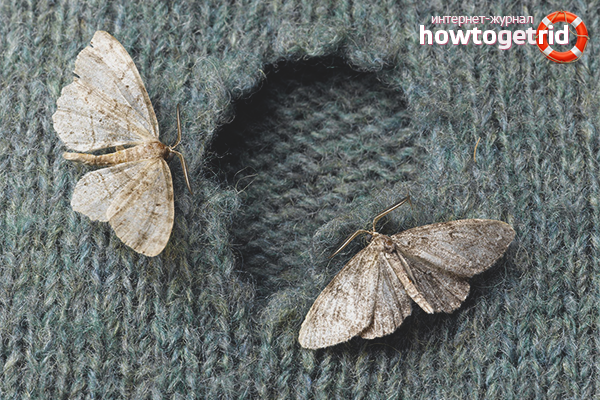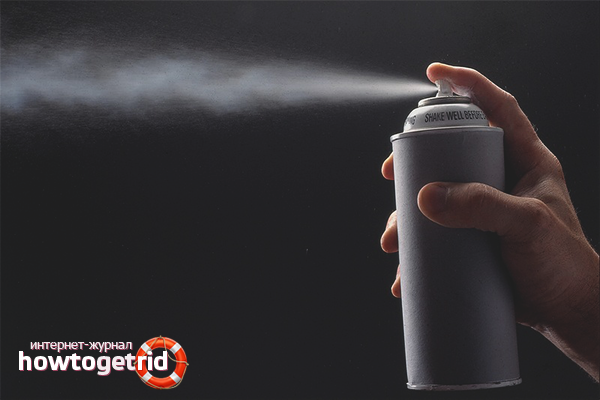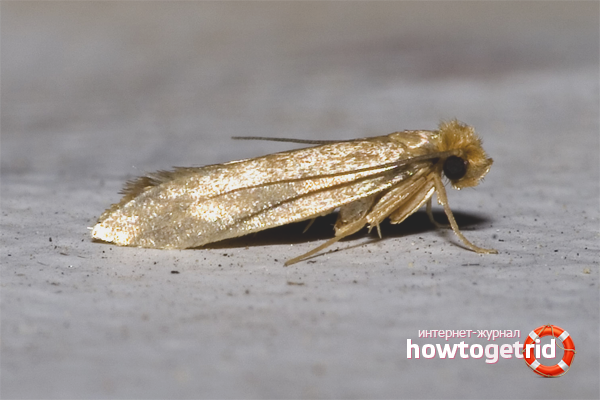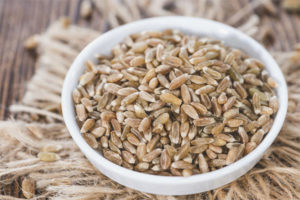The content of the article
Have you once again opened winter things before the start of the season and found a few holes in your favorite sweater? This means that the moth, or rather, its larva, is to blame for this unpleasant incident. After all, an adult does not eat organic products. But it can lay larvae in huge quantities. They then eat everything around. Do not think that the moth is scary only for the wardrobe. This unpleasant insect can settle in the kitchen and in the pantry, slowly but surely devouring your food supplies. Today we’ll talk about the moth in the apartment - how and why it appears, what happens, how to deal with it in professional and home ways, and also learn about ways to protect the house from this insect.
Types of moles
There are several groups of moles, which vary depending on their taste preferences. The largest group is the kitchen moth, which is often found in food supplies. Fruit prefers dried fruits and tea, flour loves flour and can penetrate even into closed containers. Potato moth settles directly in the potato tuber and feeds on its pulp. Cereals affect the croup partially or completely. If you open a container with cereals, the remains of the moth's vital activity will be immediately visible - holes in the grains, fine dust, insect excrement, discarded skins. There is also a barn moth that loves to enjoy different nuts. These are the main groups of insects that eat food.
In addition to different types of kitchen moth, there is also a clothes moth that feeds on natural wool. It can be sweaters, lining of outerwear, upholstery of upholstered furniture, curtains, carpets. Moth can also eat pet hair. In some cases, moth also spoils simple textiles, if it is saturated with urine, then, with other organic secretions. Most often, moth lays larvae in folds of clothing, in the gaps of carpets under the sofa, that is, in secluded places. As was noted, the female can lay larvae, which need wool nutrition. The offspring of one individual can eat up to 10 kilograms of wool.
Another moth is a fur coat. The damage from her actions is especially sensitive, since natural fur and articles made of it cost a lot. In addition to fur, this insect feeds on felt, felt, natural feathers, down, etc. Fur moth can even eat up the end of your pet’s tail. Moth can be furniture - its addictions are very strange. Such a moth eats upholstery, both natural and synthetic. Such a moth settles in secluded places, wood gaps, behind the lining of the upholstery. In some cases, furniture moth even affects the wood itself, punching hollow passages in it. But carpet moth is considered the most difficult to remove and stable - it is not sensitive to mothballs, lays eggs deep inside the villi, and it is almost impossible to find them.
Knowing the types of moths and their places of residence, it is possible to eradicate these insects in a better way. How to act if a moth was found in the house?
What to do if a mole appears in the apartment
To evict an unexpected guest and prevent his return visit, you need to act in an integrated manner.
- If you find some kind of moth in your apartment, look at other parts of the home. The fact is that moth rarely settles in the house alone. If insects appear in the kitchen, carefully inspect all food supplies, cupboards, and textiles in the home.
- If a nest of moth larvae is found, it must be eliminated.To do this, vacuum the entire affected area, rinse it with a sponge and water. In addition to soap, you need to add a small amount of detergent with chlorine to the water.
- If moth is found in the closet, carefully and painstakingly shake all clothing, even synthetics. After all, insects do not always lay offspring in edible wool.
- Ideally, all clothing should be rubbed in the high-temperature wash mode. Massive woolen sweaters can be cleaned of larvae in another way - just put the clothes in the freezer for several hours - the larvae will not survive. Large outer clothing should be cleaned with a brush, especially folds, pockets, hard-to-reach areas of the lining. Ideally, jackets, fur coats and coats can be treated with a steam generator, this will not leave the larva any chance.
- Rearrange everything that is possible - curtains, carpets, drapes. If the item is not washable, it must be left in direct sunlight for several hours - a mole will not survive.
- If a mole has struck your kitchen, a thorough audit is also needed here. Affected grains, dried fruits and nuts can no longer be saved, and you can’t eat them. Therefore, they are sent without regret to the trash. All containers, cabinets and the most inaccessible places should be washed with chlorine or vinegar solution, allow the drawers to be sufficiently ventilated.
These simple measures will help you eliminate the visible foci and nests of the moth. But often this is not enough and just one unnoticed larva can reproduce the population in large sizes. What to do in these cases?
Professional ways to deal with moths
Here we talk about household chemical insecticides that are designed to kill flying insects.
- Aerosols. The largest group is presented in the form of sprays. They must be used clearly according to the instructions. As a rule, poison is sprayed in cabinets and inaccessible areas of carpets, furniture, etc. After that, you need to close all the windows and doors in the house, leave the apartment for several hours. Processing must be carried out in a respiratory mask. Then everything is thoroughly washed, clothes are washed. Aerosols will help to get rid not only of adults, but also of larvae. Here are some popular insecticides. Dichlorvos can only be sprayed on hard surfaces, such as in a cabinet. Antimole is very effective against moths. Armol is suitable for textiles. Raptor gives excellent results - it affects the respiratory system of larvae and kills them. This tool is safe for humans. Many aerosols cannot be used in the kitchen. Sprays such as Clean House, Morimol, Fox, Maskitol, etc. are also effective.
- Fumigator. The fumigator is a device that plugs into an outlet. When heated, a plate or a special insecticidal liquid evaporates and releases special components that kill the mole into the air. For people, a fumigator is considered safer than an aerosol. Most manufacturers make insecticides in different formats - aerosols, traps, fumigators, you can use what is more convenient for you. The fumigator has a small area of damage, but it is very convenient to use to disinfect the cabinet if you place the device inside with an extension cord. In this case, you do not have to wash all the clothes.
- Pheromone traps. This is one of the safest and most effective ways to clean your house of moths. Traps are a small piece of cardboard that emits a subtle smell of the pheromones of a female moth. The male flies to an attractive aroma and firmly sticks to cardboard. The life cycle ends, there is no one else to reproduce offspring. But you need to know one rule - you cannot hang several traps in a room at once - an excessive smell disorientates the males.
- Plates. These are small pieces of cardboard or organic material saturated with special perfumes and insecticides.You just need to place the plates in the cupboard. This will get rid of the existing moth and prevent its re-settlement. Plates - this is one of the most durable insect repellents - the action of the device lasts up to several months.
These are the most popular, effective and safe means of destroying moths and its larvae. But is it always worth resorting to chemical insecticides? You can try to get rid of the moth with the help of folk remedies, especially if there are old people, children or pregnant women at home.
Home remedies for moths
Here are a few recipes that do not kill the mole, but perfectly scare it off.
- Herbs. Put fragrant smelling herbs in the cupboard that will scare away the moth. Among them are wormwood, tansy, tobacco, geranium, mint, eucalyptus, cloves, walnut leaves. So that the branches do not mold, they must first be dried, and then placed in fabric bags so that they do not crumble and do not litter.
- Toilet soap. Many cosmetic fragrances have a rather pungent odor, which also repels moths and other insects. Put pungent soap in the pockets of your coat and wrap it in woolen sweaters.
- Citrus zest. Earlier in the New Year, there were a lot of tangerine peels, but experienced housewives did not throw it in the trash. Fragrant citrus peel can be put not only in the wardrobe, but also on the kitchen shelves, unlike soaps and herbs.
- Lavender. Lavender essential oil will not only save you from moths, but also give your clothes a pleasant floral aroma.
These simple recommendations will help you not only solve the problem completely, but also forget about it forever. As long as you have protective bags in your closet, the moth will definitely not stick to you!
The moth family has more than two thousand species of this insect. The phrase "eaten by a moth" implies a description of a very old, dilapidated and abandoned thing. Unfortunately, a mole can spoil even a new thing in just a few days. Therefore, you should not neglect it. Protect your cabinets, clothes and products, use only proven products from moths!
Video: how to get rid of moths folk remedies












Submit